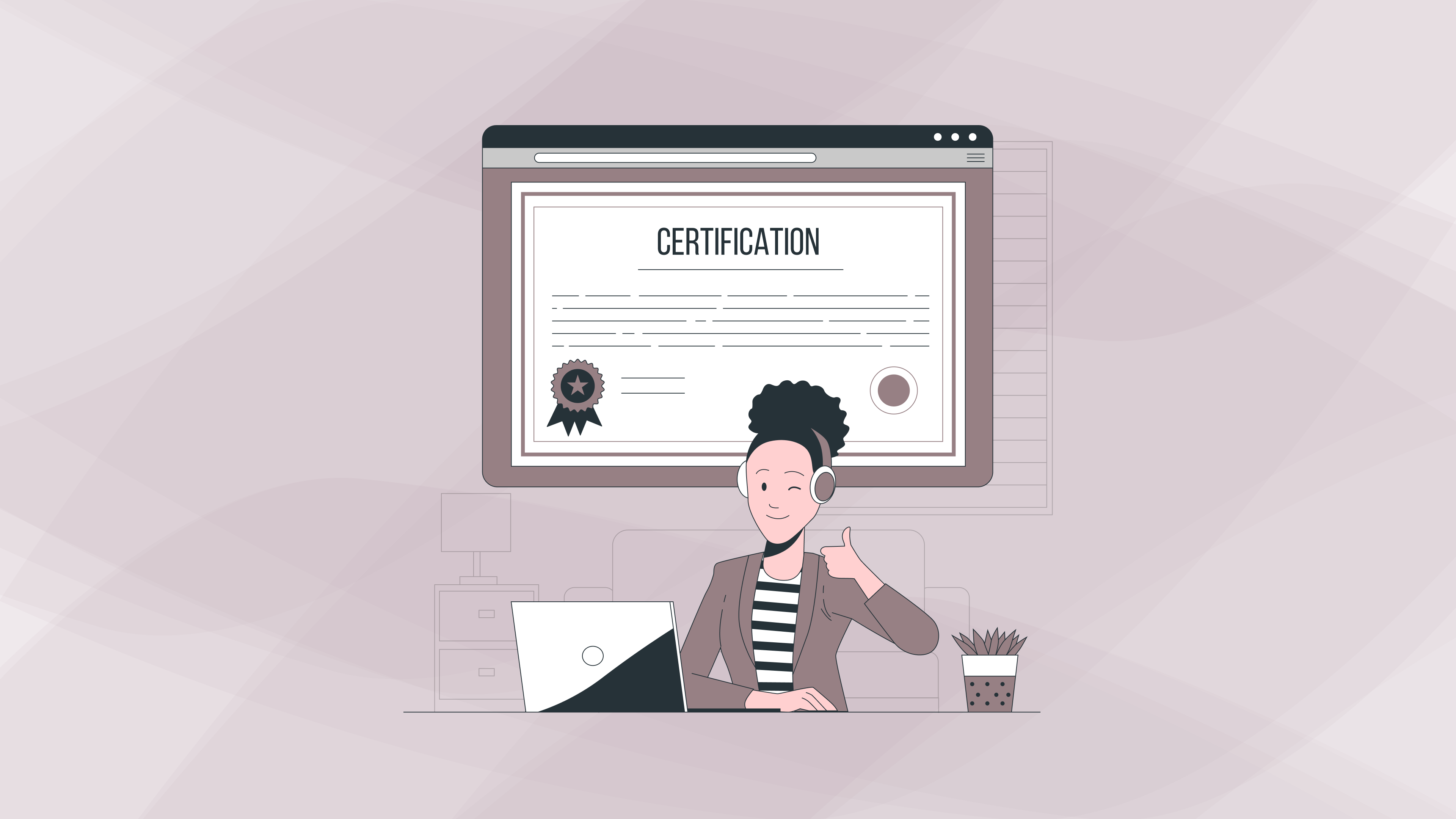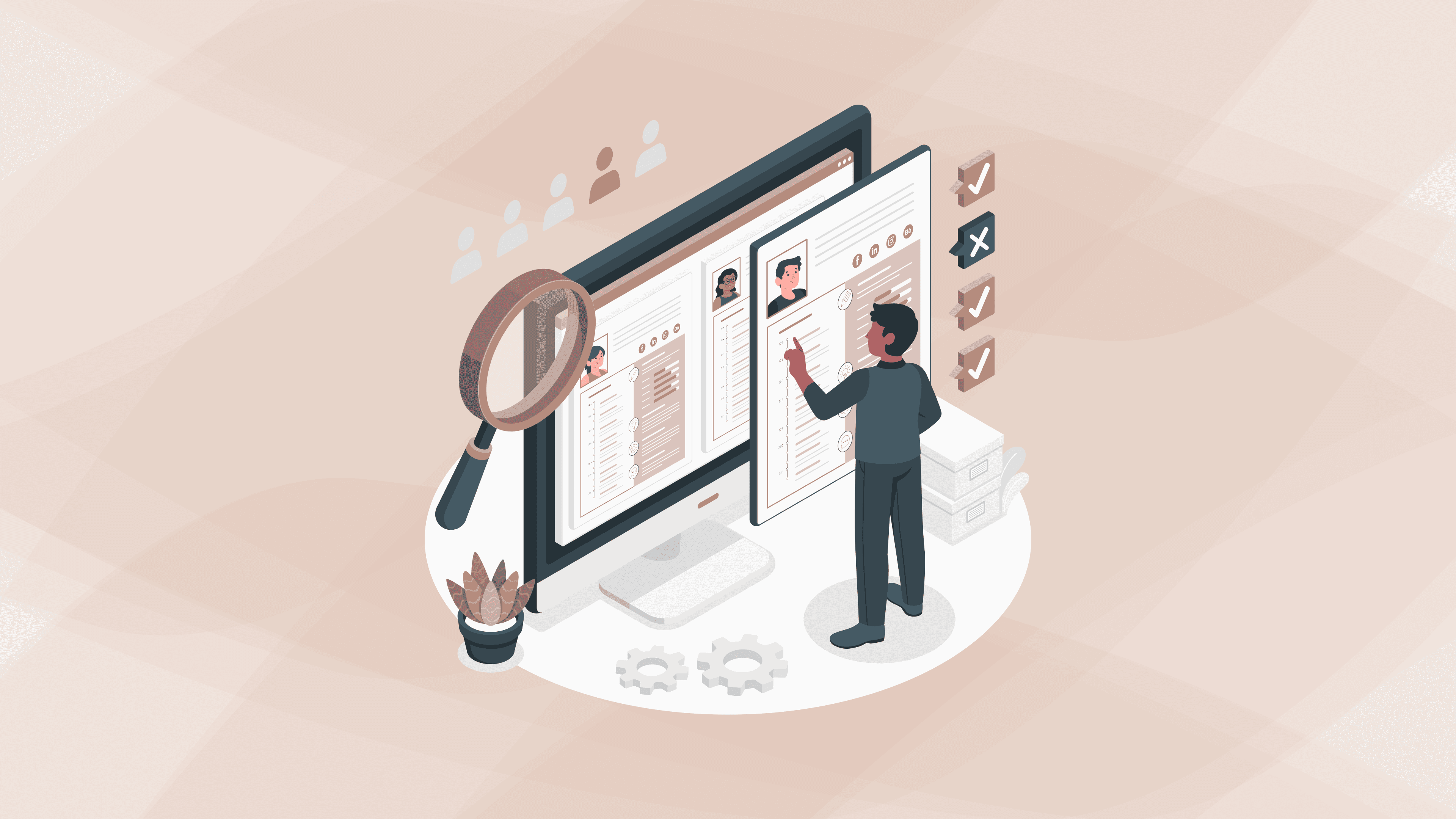Employee Verification
How Digital Credentials Improve the Speed and Accuracy of Employee Verification
How Digital Credentials Improve the Speed and Accuracy of Employee Verification
How Digital Credentials Improve the Speed and Accuracy of Employee Verification
Nov 12, 2024



Employee verification has become a critical part of the recruitment process. Employers need to verify candidates’ backgrounds, skills, and qualifications quickly and accurately to make informed hiring decisions. Traditional verification methods can be time-consuming and prone to human error, causing delays in onboarding and risking misinterpretations of a candidate’s credentials. However, digital credentials are transforming the employee verification process, making it faster, more reliable, and more secure.
In this blog, we’ll discuss how digital credentials enhance the speed and accuracy of employee verification, and how both employers and employees benefit from these advancements.
What Are Digital Credentials?
Digital credentials are verified, portable, and tamper-proof representations of an individual's qualifications, skills, and achievements. Stored and shared digitally, they include certifications, diplomas, degrees, skills verifications, and more. These credentials are often issued by educational institutions, professional organizations, or verified digital credential platforms, ensuring their authenticity and ease of access for employers.
Digital credentials use secure technology, such as blockchain, to make records permanent, trustworthy, and verifiable, allowing employers to quickly verify an employee’s skills, education, and experience.
The Importance of Employee Verification
Employee verification is essential for maintaining a qualified and reliable workforce. Verification checks confirm a candidate’s:
Educational qualifications: Ensuring they meet the minimum education requirements.
Employment history: Confirming previous roles and responsibilities.
Professional certifications: Validating specialized skills or knowledge.
Identity and background: Ensuring safety and compliance.
Accurate verification reduces hiring risks, improves hiring speed, and enhances the overall quality of the workforce. With digital credentials, employee verification becomes an efficient, streamlined process that supports accurate, timely hiring.
How Digital Credentials Enhance Employee Verification
Digital credentials bring numerous advantages to the employee verification process, improving both speed and accuracy. Here’s how:
1. Instant Access to Verified Credentials
Traditional verification methods, like contacting universities or previous employers, can take days or weeks. Digital credentials, on the other hand, allow employers to access verified information almost instantly. For example, education credentials issued through platforms like DigiLocker or Credly enable employers to validate degrees or certifications immediately. This instant access speeds up the hiring process, especially for roles where quick onboarding is essential.
2. Increased Accuracy with Tamper-Proof Records
Digital credentials are often stored using blockchain technology, making them tamper-proof and highly reliable. Unlike paper certificates that can be forged or altered, blockchain-backed digital credentials cannot be manipulated. This increased accuracy gives employers confidence that the information they’re verifying is legitimate and trustworthy, reducing the risk of hiring based on false credentials.
3. Simplified Verification Process
Digital credential platforms allow candidates to share verified credentials directly with employers, eliminating the need for third-party verification services. Employers can review these credentials through secure links or QR codes provided by the platform. This direct verification streamlines the process and eliminates middlemen, reducing administrative overhead and making the verification process simpler and faster.
4. Cost Savings for Employers
Manual verification processes can be resource-intensive, often requiring administrative staff to handle verification calls, emails, and paperwork. By using digital credentials, companies can significantly cut down on these operational costs. Verification becomes automated, reducing the need for third-party verification agencies and allowing HR teams to focus on core hiring activities.
5. Improved Compliance with Industry Standards
Certain industries, such as finance and healthcare, require stringent employee verification to comply with regulatory standards. Digital credentials improve compliance by providing a secure and auditable trail of the employee’s qualifications and certifications. Employers can quickly access the credentials needed to meet regulatory requirements, reducing the risk of non-compliance and potential legal issues.
6. Enhanced Candidate Experience
Digital credentials also enhance the hiring experience for candidates. Instead of waiting for third-party verifications to complete, candidates can quickly share their credentials with employers. This reduces delays in the hiring process, allows candidates to control their data sharing securely, and ultimately creates a more positive recruitment experience.
Key Benefits of Digital Credentials for Employee Verification
Let’s dive into some of the key benefits that digital credentials bring to the employee verification process:
A. Speed and Efficiency
With traditional verification methods, collecting and verifying candidate information can take several days. Digital credentials, however, allow for near-instant verification, accelerating the entire recruitment process. This speed is especially valuable for companies that need to fill positions quickly.
B. Data Security and Privacy
Digital credentials are typically secured by encryption and blockchain technology, which protect sensitive data and prevent unauthorized access. This data security ensures that both the employer and employee’s data privacy are maintained throughout the verification process.
C. Transparency and Trust
Digital credentials provide an open, transparent record of an individual’s qualifications, accessible anytime by both employers and candidates. This transparency fosters trust between both parties, as employers are assured of the credentials’ authenticity while candidates are confident that their qualifications are accurately represented.
D. Portability and Ease of Access
Candidates can store and access digital credentials on secure platforms and easily share them with multiple employers or organizations as needed. This portability means that candidates don’t have to repeatedly request verification from previous employers or institutions, while employers benefit from seamless access to relevant information.
E. Supports Remote Hiring
With the rise of remote work, digital credentials support verification across geographical boundaries without the need for in-person checks. Companies can verify candidates’ backgrounds regardless of location, making it easier to hire remote talent from anywhere in the world.
Digital Credential Technologies in Employee Verification
1. Blockchain Technology
Blockchain is often used to store digital credentials securely. Blockchain-based credentials are decentralized, meaning they are highly secure and cannot be tampered with. These credentials are validated and stored permanently, ensuring that they remain accurate and authentic throughout an employee’s career.
2. QR Codes and Secure Links
Many digital credential platforms use QR codes or secure links, which candidates can easily share with employers. By scanning the QR code or accessing the link, employers can instantly verify a candidate’s credentials, eliminating the need for manual validation steps.
3. Integrated Credential Platforms
Platforms like DigiLocker, Truscholar, and Credly offer integrated credential management systems where candidates can upload, verify, and share their credentials with employers. These platforms provide a comprehensive solution that improves both the accessibility and authenticity of digital credentials.
Implementing Digital Credentials in Employee Verification
For companies looking to adopt digital credentials, here are some best practices to ensure smooth implementation:
Choose Reputable Credentialing Platforms: Partner with trusted credentialing platforms that comply with industry standards, such as Credly or DigiLocker, to ensure security and accuracy.
Integrate with Existing HR Systems: Look for credentialing solutions that can integrate with your HR software, enabling seamless verification without additional steps.
Train HR Teams on Digital Verification: Provide training to HR and recruitment teams to familiarize them with digital credentialing processes and tools.
Encourage Candidates to Use Digital Credentials: Communicate with candidates about the benefits of digital credentials and encourage them to adopt these methods for easier verification.
Stay Updated on Compliance: Ensure that the digital credential solution you choose complies with data privacy laws and industry regulations.
Conclusion
Digital credentials are revolutionizing the employee verification process by making it faster, more secure, and highly accurate. For both employers and candidates, digital credentials offer a win-win solution, enabling quick access to verified information without the delays and inaccuracies associated with traditional verification methods. With technologies like blockchain and secure credential platforms, companies can ensure that they’re making informed hiring decisions while maintaining compliance and reducing operational costs.
As digital credentials continue to grow in adoption, they’re set to become an industry standard in employee verification, supporting a streamlined, transparent, and efficient hiring process that benefits all parties involved.
Employee verification has become a critical part of the recruitment process. Employers need to verify candidates’ backgrounds, skills, and qualifications quickly and accurately to make informed hiring decisions. Traditional verification methods can be time-consuming and prone to human error, causing delays in onboarding and risking misinterpretations of a candidate’s credentials. However, digital credentials are transforming the employee verification process, making it faster, more reliable, and more secure.
In this blog, we’ll discuss how digital credentials enhance the speed and accuracy of employee verification, and how both employers and employees benefit from these advancements.
What Are Digital Credentials?
Digital credentials are verified, portable, and tamper-proof representations of an individual's qualifications, skills, and achievements. Stored and shared digitally, they include certifications, diplomas, degrees, skills verifications, and more. These credentials are often issued by educational institutions, professional organizations, or verified digital credential platforms, ensuring their authenticity and ease of access for employers.
Digital credentials use secure technology, such as blockchain, to make records permanent, trustworthy, and verifiable, allowing employers to quickly verify an employee’s skills, education, and experience.
The Importance of Employee Verification
Employee verification is essential for maintaining a qualified and reliable workforce. Verification checks confirm a candidate’s:
Educational qualifications: Ensuring they meet the minimum education requirements.
Employment history: Confirming previous roles and responsibilities.
Professional certifications: Validating specialized skills or knowledge.
Identity and background: Ensuring safety and compliance.
Accurate verification reduces hiring risks, improves hiring speed, and enhances the overall quality of the workforce. With digital credentials, employee verification becomes an efficient, streamlined process that supports accurate, timely hiring.
How Digital Credentials Enhance Employee Verification
Digital credentials bring numerous advantages to the employee verification process, improving both speed and accuracy. Here’s how:
1. Instant Access to Verified Credentials
Traditional verification methods, like contacting universities or previous employers, can take days or weeks. Digital credentials, on the other hand, allow employers to access verified information almost instantly. For example, education credentials issued through platforms like DigiLocker or Credly enable employers to validate degrees or certifications immediately. This instant access speeds up the hiring process, especially for roles where quick onboarding is essential.
2. Increased Accuracy with Tamper-Proof Records
Digital credentials are often stored using blockchain technology, making them tamper-proof and highly reliable. Unlike paper certificates that can be forged or altered, blockchain-backed digital credentials cannot be manipulated. This increased accuracy gives employers confidence that the information they’re verifying is legitimate and trustworthy, reducing the risk of hiring based on false credentials.
3. Simplified Verification Process
Digital credential platforms allow candidates to share verified credentials directly with employers, eliminating the need for third-party verification services. Employers can review these credentials through secure links or QR codes provided by the platform. This direct verification streamlines the process and eliminates middlemen, reducing administrative overhead and making the verification process simpler and faster.
4. Cost Savings for Employers
Manual verification processes can be resource-intensive, often requiring administrative staff to handle verification calls, emails, and paperwork. By using digital credentials, companies can significantly cut down on these operational costs. Verification becomes automated, reducing the need for third-party verification agencies and allowing HR teams to focus on core hiring activities.
5. Improved Compliance with Industry Standards
Certain industries, such as finance and healthcare, require stringent employee verification to comply with regulatory standards. Digital credentials improve compliance by providing a secure and auditable trail of the employee’s qualifications and certifications. Employers can quickly access the credentials needed to meet regulatory requirements, reducing the risk of non-compliance and potential legal issues.
6. Enhanced Candidate Experience
Digital credentials also enhance the hiring experience for candidates. Instead of waiting for third-party verifications to complete, candidates can quickly share their credentials with employers. This reduces delays in the hiring process, allows candidates to control their data sharing securely, and ultimately creates a more positive recruitment experience.
Key Benefits of Digital Credentials for Employee Verification
Let’s dive into some of the key benefits that digital credentials bring to the employee verification process:
A. Speed and Efficiency
With traditional verification methods, collecting and verifying candidate information can take several days. Digital credentials, however, allow for near-instant verification, accelerating the entire recruitment process. This speed is especially valuable for companies that need to fill positions quickly.
B. Data Security and Privacy
Digital credentials are typically secured by encryption and blockchain technology, which protect sensitive data and prevent unauthorized access. This data security ensures that both the employer and employee’s data privacy are maintained throughout the verification process.
C. Transparency and Trust
Digital credentials provide an open, transparent record of an individual’s qualifications, accessible anytime by both employers and candidates. This transparency fosters trust between both parties, as employers are assured of the credentials’ authenticity while candidates are confident that their qualifications are accurately represented.
D. Portability and Ease of Access
Candidates can store and access digital credentials on secure platforms and easily share them with multiple employers or organizations as needed. This portability means that candidates don’t have to repeatedly request verification from previous employers or institutions, while employers benefit from seamless access to relevant information.
E. Supports Remote Hiring
With the rise of remote work, digital credentials support verification across geographical boundaries without the need for in-person checks. Companies can verify candidates’ backgrounds regardless of location, making it easier to hire remote talent from anywhere in the world.
Digital Credential Technologies in Employee Verification
1. Blockchain Technology
Blockchain is often used to store digital credentials securely. Blockchain-based credentials are decentralized, meaning they are highly secure and cannot be tampered with. These credentials are validated and stored permanently, ensuring that they remain accurate and authentic throughout an employee’s career.
2. QR Codes and Secure Links
Many digital credential platforms use QR codes or secure links, which candidates can easily share with employers. By scanning the QR code or accessing the link, employers can instantly verify a candidate’s credentials, eliminating the need for manual validation steps.
3. Integrated Credential Platforms
Platforms like DigiLocker, Truscholar, and Credly offer integrated credential management systems where candidates can upload, verify, and share their credentials with employers. These platforms provide a comprehensive solution that improves both the accessibility and authenticity of digital credentials.
Implementing Digital Credentials in Employee Verification
For companies looking to adopt digital credentials, here are some best practices to ensure smooth implementation:
Choose Reputable Credentialing Platforms: Partner with trusted credentialing platforms that comply with industry standards, such as Credly or DigiLocker, to ensure security and accuracy.
Integrate with Existing HR Systems: Look for credentialing solutions that can integrate with your HR software, enabling seamless verification without additional steps.
Train HR Teams on Digital Verification: Provide training to HR and recruitment teams to familiarize them with digital credentialing processes and tools.
Encourage Candidates to Use Digital Credentials: Communicate with candidates about the benefits of digital credentials and encourage them to adopt these methods for easier verification.
Stay Updated on Compliance: Ensure that the digital credential solution you choose complies with data privacy laws and industry regulations.
Conclusion
Digital credentials are revolutionizing the employee verification process by making it faster, more secure, and highly accurate. For both employers and candidates, digital credentials offer a win-win solution, enabling quick access to verified information without the delays and inaccuracies associated with traditional verification methods. With technologies like blockchain and secure credential platforms, companies can ensure that they’re making informed hiring decisions while maintaining compliance and reducing operational costs.
As digital credentials continue to grow in adoption, they’re set to become an industry standard in employee verification, supporting a streamlined, transparent, and efficient hiring process that benefits all parties involved.
Employee verification has become a critical part of the recruitment process. Employers need to verify candidates’ backgrounds, skills, and qualifications quickly and accurately to make informed hiring decisions. Traditional verification methods can be time-consuming and prone to human error, causing delays in onboarding and risking misinterpretations of a candidate’s credentials. However, digital credentials are transforming the employee verification process, making it faster, more reliable, and more secure.
In this blog, we’ll discuss how digital credentials enhance the speed and accuracy of employee verification, and how both employers and employees benefit from these advancements.
What Are Digital Credentials?
Digital credentials are verified, portable, and tamper-proof representations of an individual's qualifications, skills, and achievements. Stored and shared digitally, they include certifications, diplomas, degrees, skills verifications, and more. These credentials are often issued by educational institutions, professional organizations, or verified digital credential platforms, ensuring their authenticity and ease of access for employers.
Digital credentials use secure technology, such as blockchain, to make records permanent, trustworthy, and verifiable, allowing employers to quickly verify an employee’s skills, education, and experience.
The Importance of Employee Verification
Employee verification is essential for maintaining a qualified and reliable workforce. Verification checks confirm a candidate’s:
Educational qualifications: Ensuring they meet the minimum education requirements.
Employment history: Confirming previous roles and responsibilities.
Professional certifications: Validating specialized skills or knowledge.
Identity and background: Ensuring safety and compliance.
Accurate verification reduces hiring risks, improves hiring speed, and enhances the overall quality of the workforce. With digital credentials, employee verification becomes an efficient, streamlined process that supports accurate, timely hiring.
How Digital Credentials Enhance Employee Verification
Digital credentials bring numerous advantages to the employee verification process, improving both speed and accuracy. Here’s how:
1. Instant Access to Verified Credentials
Traditional verification methods, like contacting universities or previous employers, can take days or weeks. Digital credentials, on the other hand, allow employers to access verified information almost instantly. For example, education credentials issued through platforms like DigiLocker or Credly enable employers to validate degrees or certifications immediately. This instant access speeds up the hiring process, especially for roles where quick onboarding is essential.
2. Increased Accuracy with Tamper-Proof Records
Digital credentials are often stored using blockchain technology, making them tamper-proof and highly reliable. Unlike paper certificates that can be forged or altered, blockchain-backed digital credentials cannot be manipulated. This increased accuracy gives employers confidence that the information they’re verifying is legitimate and trustworthy, reducing the risk of hiring based on false credentials.
3. Simplified Verification Process
Digital credential platforms allow candidates to share verified credentials directly with employers, eliminating the need for third-party verification services. Employers can review these credentials through secure links or QR codes provided by the platform. This direct verification streamlines the process and eliminates middlemen, reducing administrative overhead and making the verification process simpler and faster.
4. Cost Savings for Employers
Manual verification processes can be resource-intensive, often requiring administrative staff to handle verification calls, emails, and paperwork. By using digital credentials, companies can significantly cut down on these operational costs. Verification becomes automated, reducing the need for third-party verification agencies and allowing HR teams to focus on core hiring activities.
5. Improved Compliance with Industry Standards
Certain industries, such as finance and healthcare, require stringent employee verification to comply with regulatory standards. Digital credentials improve compliance by providing a secure and auditable trail of the employee’s qualifications and certifications. Employers can quickly access the credentials needed to meet regulatory requirements, reducing the risk of non-compliance and potential legal issues.
6. Enhanced Candidate Experience
Digital credentials also enhance the hiring experience for candidates. Instead of waiting for third-party verifications to complete, candidates can quickly share their credentials with employers. This reduces delays in the hiring process, allows candidates to control their data sharing securely, and ultimately creates a more positive recruitment experience.
Key Benefits of Digital Credentials for Employee Verification
Let’s dive into some of the key benefits that digital credentials bring to the employee verification process:
A. Speed and Efficiency
With traditional verification methods, collecting and verifying candidate information can take several days. Digital credentials, however, allow for near-instant verification, accelerating the entire recruitment process. This speed is especially valuable for companies that need to fill positions quickly.
B. Data Security and Privacy
Digital credentials are typically secured by encryption and blockchain technology, which protect sensitive data and prevent unauthorized access. This data security ensures that both the employer and employee’s data privacy are maintained throughout the verification process.
C. Transparency and Trust
Digital credentials provide an open, transparent record of an individual’s qualifications, accessible anytime by both employers and candidates. This transparency fosters trust between both parties, as employers are assured of the credentials’ authenticity while candidates are confident that their qualifications are accurately represented.
D. Portability and Ease of Access
Candidates can store and access digital credentials on secure platforms and easily share them with multiple employers or organizations as needed. This portability means that candidates don’t have to repeatedly request verification from previous employers or institutions, while employers benefit from seamless access to relevant information.
E. Supports Remote Hiring
With the rise of remote work, digital credentials support verification across geographical boundaries without the need for in-person checks. Companies can verify candidates’ backgrounds regardless of location, making it easier to hire remote talent from anywhere in the world.
Digital Credential Technologies in Employee Verification
1. Blockchain Technology
Blockchain is often used to store digital credentials securely. Blockchain-based credentials are decentralized, meaning they are highly secure and cannot be tampered with. These credentials are validated and stored permanently, ensuring that they remain accurate and authentic throughout an employee’s career.
2. QR Codes and Secure Links
Many digital credential platforms use QR codes or secure links, which candidates can easily share with employers. By scanning the QR code or accessing the link, employers can instantly verify a candidate’s credentials, eliminating the need for manual validation steps.
3. Integrated Credential Platforms
Platforms like DigiLocker, Truscholar, and Credly offer integrated credential management systems where candidates can upload, verify, and share their credentials with employers. These platforms provide a comprehensive solution that improves both the accessibility and authenticity of digital credentials.
Implementing Digital Credentials in Employee Verification
For companies looking to adopt digital credentials, here are some best practices to ensure smooth implementation:
Choose Reputable Credentialing Platforms: Partner with trusted credentialing platforms that comply with industry standards, such as Credly or DigiLocker, to ensure security and accuracy.
Integrate with Existing HR Systems: Look for credentialing solutions that can integrate with your HR software, enabling seamless verification without additional steps.
Train HR Teams on Digital Verification: Provide training to HR and recruitment teams to familiarize them with digital credentialing processes and tools.
Encourage Candidates to Use Digital Credentials: Communicate with candidates about the benefits of digital credentials and encourage them to adopt these methods for easier verification.
Stay Updated on Compliance: Ensure that the digital credential solution you choose complies with data privacy laws and industry regulations.
Conclusion
Digital credentials are revolutionizing the employee verification process by making it faster, more secure, and highly accurate. For both employers and candidates, digital credentials offer a win-win solution, enabling quick access to verified information without the delays and inaccuracies associated with traditional verification methods. With technologies like blockchain and secure credential platforms, companies can ensure that they’re making informed hiring decisions while maintaining compliance and reducing operational costs.
As digital credentials continue to grow in adoption, they’re set to become an industry standard in employee verification, supporting a streamlined, transparent, and efficient hiring process that benefits all parties involved.
Schedule your Free Demo
Schedule your Free Demo
Empower Your Organization’s Growth with the Future of Digital Credentials.
Book a Demo
You Might Also Like
You Might Also Like
You Might Also Like

HR Insight
How to streamlines daily HR tasks with efficient solutions
Jan 22, 2025

Skill-Based Hiring
Why Skill-Based Hiring Is the Key to Building a Future-Ready Workforce
Jan 21, 2025

Blockchain
The Role of Blockchain in Transforming Skill-Based Hiring Processes
Jan 21, 2025

Truskillforce
10 strategies to enhance your professional growth
Jan 21, 2025

Talent Search
How to Attract top talent in a competitive market
Jan 21, 2025

Hiring
How TruSkillForce Helps Employers Save Time & Resources in Hiring
Jan 21, 2025

HR Insight
How to streamlines daily HR tasks with efficient solutions
Jan 22, 2025

Skill-Based Hiring
Why Skill-Based Hiring Is the Key to Building a Future-Ready Workforce
Jan 21, 2025

Blockchain
The Role of Blockchain in Transforming Skill-Based Hiring Processes
Jan 21, 2025

Truskillforce
10 strategies to enhance your professional growth
Jan 21, 2025

HR Insight
How to streamlines daily HR tasks with efficient solutions
Jan 22, 2025

Skill-Based Hiring
Why Skill-Based Hiring Is the Key to Building a Future-Ready Workforce
Jan 21, 2025

Blockchain
The Role of Blockchain in Transforming Skill-Based Hiring Processes
Jan 21, 2025

Truskillforce
10 strategies to enhance your professional growth
Jan 21, 2025